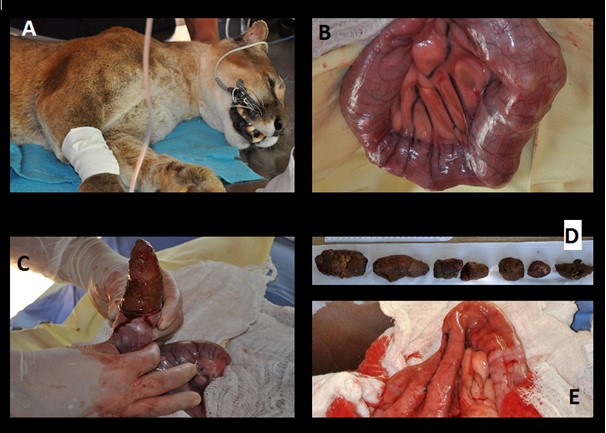Surgical treatment of intestinal obstruction by fecaloma in a puma (Puma concolor)
DOI:
https://doi.org/10.21708/avb.2019.13.4.8643Abstract
The puma (Puma concolor) is a large felid native to the Americas and one of the endangered species of the Brazilian fauna. Digestive disorders such as fecalomas are common in veterinary practice. Fecalomas are masses of retained feces that accumulate in the large colon and progress to hard fecal concretions that are difficult and painful to expel. Inadequate diets and mechanical intraluminal or extraluminal intestinal obstructions are the major causes of fecaloma. Tenesmus, anorexia, vomiting and dehydration are common clinical signs. The diagnosis is based on medical history and physical examination, and can be confirmed by imaging assessment. Fecalomas are amenable to conservative and surgical treatment, depending on disease severity. This paper describes a case of fecaloma in a puma. The diagnosis was made during exploratory laparotomy and improper diet incriminated as the cause. Surgical intervention consisted of enterotomy followed by removal hardened retained feces. Postoperative dietary management consisted of a liquid follow by a soft diet, with reintroduction of the regular diet after full recovery. Dietary supplementation with vegetable fibers was prescribed for life to prevent recurrence.
Downloads

Downloads
Published
Issue
Section
License
Autores que publicam na Acta Veterinaria Brasilica concordam com os seguintes termos: a) Autores mantém os direitos autorais e concedem à revista o direito de primeira publicação, com o trabalho simultaneamente licenciado sob a Licença Creative Commons Attribution que permite o compartilhamento do trabalho com reconhecimento da autoria e publicação inicial nesta revista. b) Autores têm autorização para assumir contratos adicionais separadamente, para distribuição não-exclusiva da versão do trabalho publicada nesta revista (ex.: publicar em repositório institucional ou como capítulo de livro), com reconhecimento de autoria e publicação inicial nesta revista. c) Autores têm permissão e são estimulados a publicar e distribuir seu trabalho online (ex.: em repositórios institucionais ou na sua página pessoal) a qualquer ponto antes ou durante o processo editorial, já que isso pode gerar alterações produtivas, bem como aumentar o impacto e a citação do trabalho publicado (Veja O Efeito do Acesso Livre).


 Esta obra está licenciada com uma Licença
Esta obra está licenciada com uma Licença 